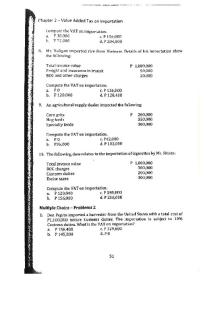Sec3 - Lecture notes CHAPTER 3 PDF

| Title | Sec3 - Lecture notes CHAPTER 3 |
|---|---|
| Course | Statistical Methods |
| Institution | Texas A&M University |
| Pages | 3 |
| File Size | 197.8 KB |
| File Type | |
| Total Downloads | 24 |
| Total Views | 127 |
Summary
3.3...
Description
Section 3.3 - Method of Corners Any point in the solution set (also called feasible region) is called a A feasible solution that optimizes the objective function is called an Theorem 1. If the feasible region of a linear programming problem is optimal solution must occur at one of the .
. . , then the
Example 1. Find the maximum and minimum value of the objective function P = 2x + y on the feasible region S .
Finding optimal solution using method of corners: 1. 2. 3. 4.
Graph the constraints and determine the solution set. If the solution set is bounded, find the corner points. Evaluate the objective function at each corner point. Determine the maximum (or minimum) value.
Example 2. Maximize P = 4x + 3y subject to the constraints: 2x + y ≤ 10,
c Priyanga Ganesan
2x + 3y ≤ 18,
x ≥ 0,
y ≥ 0.
Page 1 of 3
Example 3. Minimize C = 10x + 15y subject to the constraints x + y ≤ 10,
Theorem 2. If the solution set is
3x + y ≥ 12,
x ≥ 0,
y ≥ 3.
, then an optimal solution may or may not exist.
If the objective function is P = ax + by, where a, b are the constraints include x ≥ 0, y ≥ 0, then P has a And P has an maximum value.
numbers and value at one of the corners.
Example 4. Find the maximum and minimum value of P = x + 2y, subject to the constraints: −2x + y ≤ 4,
c Priyanga Ganesan
x + y ≥ 2,
x ≥ 0,
y ≥ 0.
Page 2 of 3
Example 5. You manage an ice cream factory that makes two flavors: Vanilla and Mocha. Each cup of Vanilla requires 2 eggs and 3 cups of cream. Each cup of Mocha requires 1 egg and 4 cups of cream. You have in stock 500 eggs and 1200 cups of cream. You make a profit of $3 on each cup of Vanilla and $5 on each cup of Mocha. Your goal is to make as much profit as possible with the available material. 1. Set up the linear programming problem to determine the number of cups of each flavor that you should make.
2. Graph the feasible region.What is the maximum profit you can make?
3. How many cups of each flavor should you make in order to earn the largest profit?
4. Are there any leftover resources?
Remark: In some problems, there might be NO feasible region! (Try: x ≥ 0, y ≥ 5, x + y < 2). In this case, we say that the linear programming problem is . Highly Suggested Homework Problems: 3, 5, 15, 23, 25, 29, 31, 35, 39, 45.
c Priyanga Ganesan
Page 3 of 3...
Similar Free PDFs

Sec3 - Lecture notes CHAPTER 3
- 3 Pages

Sec3 - Section 3 notes
- 4 Pages

Chapter 3 Lecture Notes
- 80 Pages

Lecture Notes Chapter #3
- 3 Pages

Chapter 3 Lecture Notes
- 4 Pages

Chapter 3 - lecture notes
- 38 Pages

Chapter 3 - Lecture notes 3
- 1 Pages

Chapter 3 - Lecture notes 3
- 30 Pages

Chapter 3 - Lecture notes 3
- 6 Pages

Chapter 3 - Lecture notes 3
- 6 Pages

Chapter 3 - Lecture notes 3
- 45 Pages

Chapter 3 - Lecture notes 3
- 4 Pages

Chapter 3 - Lecture notes 3
- 4 Pages

Chapter 3 - Lecture notes 3
- 3 Pages

Chapter 3 - Lecture notes 3
- 3 Pages

Chapter 3 - Lecture notes 3
- 5 Pages
Popular Institutions
- Tinajero National High School - Annex
- Politeknik Caltex Riau
- Yokohama City University
- SGT University
- University of Al-Qadisiyah
- Divine Word College of Vigan
- Techniek College Rotterdam
- Universidade de Santiago
- Universiti Teknologi MARA Cawangan Johor Kampus Pasir Gudang
- Poltekkes Kemenkes Yogyakarta
- Baguio City National High School
- Colegio san marcos
- preparatoria uno
- Centro de Bachillerato Tecnológico Industrial y de Servicios No. 107
- Dalian Maritime University
- Quang Trung Secondary School
- Colegio Tecnológico en Informática
- Corporación Regional de Educación Superior
- Grupo CEDVA
- Dar Al Uloom University
- Centro de Estudios Preuniversitarios de la Universidad Nacional de Ingeniería
- 上智大学
- Aakash International School, Nuna Majara
- San Felipe Neri Catholic School
- Kang Chiao International School - New Taipei City
- Misamis Occidental National High School
- Institución Educativa Escuela Normal Juan Ladrilleros
- Kolehiyo ng Pantukan
- Batanes State College
- Instituto Continental
- Sekolah Menengah Kejuruan Kesehatan Kaltara (Tarakan)
- Colegio de La Inmaculada Concepcion - Cebu